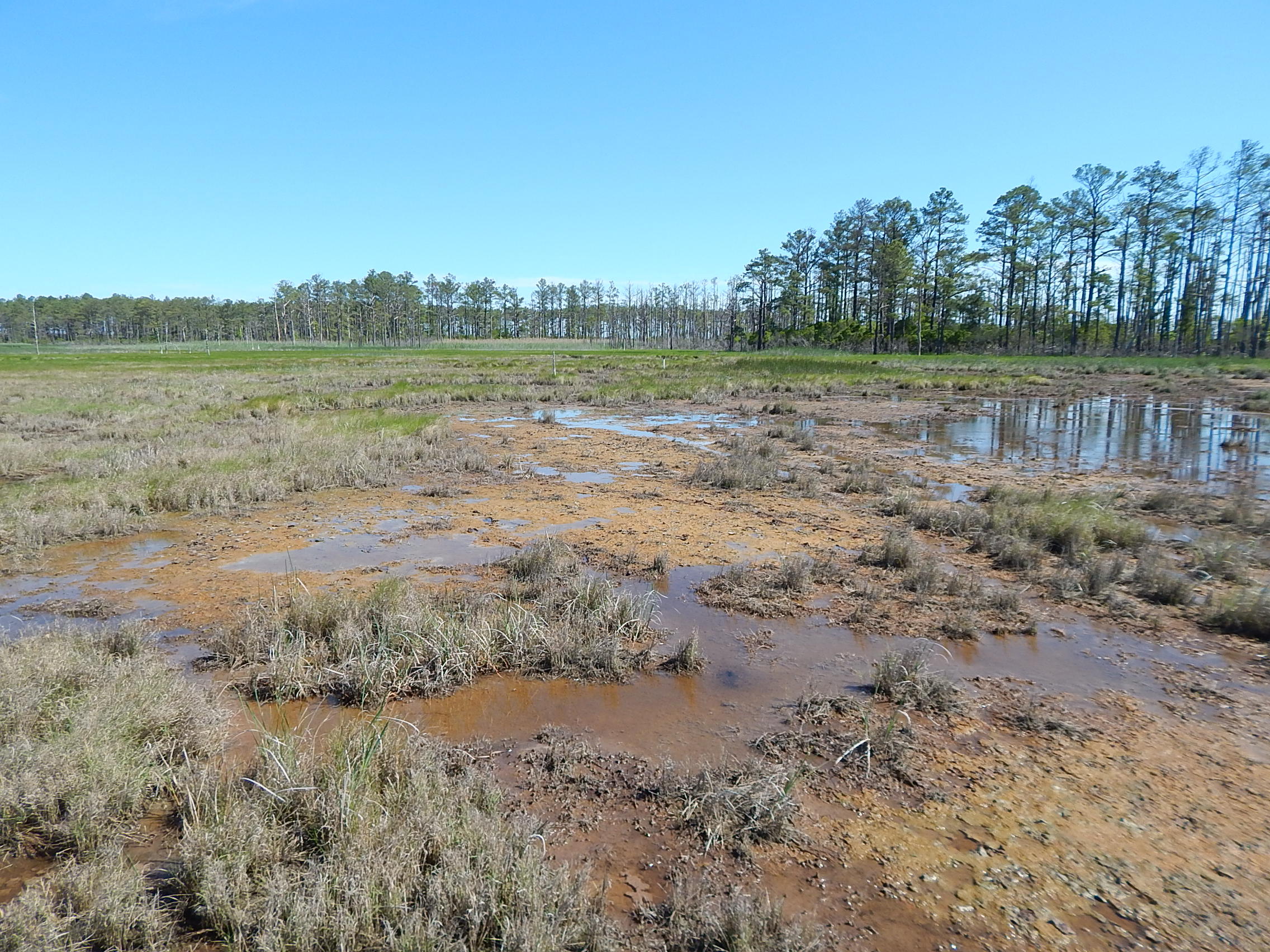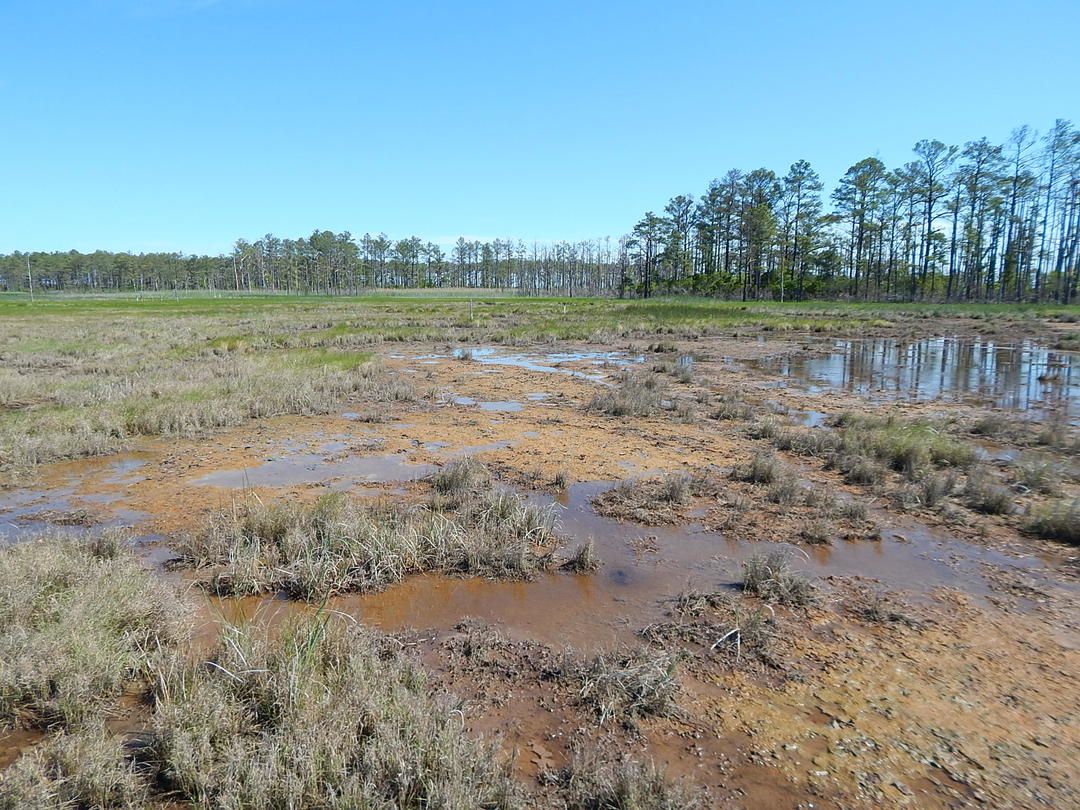Oct. 31, 2017, Baltimore, Maryland – The National Audubon Society today announced a new project to save tidal marsh in Dorchester County, Maryland from eroding to open water as sea levels in the Chesapeake Bay steadily rise.
The $475,000 project, underway at Farm Creek Marsh near Blackwater National Wildlife Refuge, is no run of the mill marsh restoration. Audubon and a cadre of federal, state, and private partners plan to introduce tidal flow to an eroding tidal marsh where the absence of creeks is preventing floodwaters from draining away. Ponded floodwaters are causing the marsh vegetation to become waterlogged resulting in decay of the root zone and then erosion to open water.
“Over recent decades this site has transitioned from pine forest to brackish marsh as storm tides have reached higher due to sea level rise,” said Dr. David Curson, director of bird conservation for Audubon Maryland-DC. “But although the vegetation has changed to tidal marsh plants, the tidal creeks haven’t worked their way into this area yet, so floodwaters from storm tides just sit there rotting out the marsh vegetation.” This erosion of recently formed marsh jeopardizing the effective migration of tidal marshes upslope as sea levels rise due to climate change.
Migration of marshes upslope could be vital to the survival of the region’s tidal wetland ecosystem. Indeed, scientists predict that, if no action is taken, all of today’s tidal wetlands in the Chesapeake Bay will erode to open water by the end of the 21st century as sea levels rise at an ever faster pace. According to the Maryland Commission for Climate Change, the current best projection of sea level rise in Maryland is 3.7 feet by 2100. By then iconic marsh birds like Black Rails and Saltmarsh Sparrows could be gone, along with essential habitat for crabs and young stages of many important fish species.
Audubon’s solution to the chronic waterlogging at Farm Creek Marsh is an engineering remedy. The project will use a low ground pressure excavator to extend the head of a nearby tidal creek by nearly a quarter of a mile into the waterlogged basin to reduce inundation, introduce tidal exchange and reinvigorate the marsh vegetation. The new channel extension will imitate the natural form and flow of a tidal creek. Scientists will monitor birds, vegetation, hydrology and the elevation of the marsh surface before and after channel construction.
The project is relying on a broad partnership to achieve its goals. Audubon’s partners include the United States Geological Survey (USGS), Maryland Department of Natural Resources, The Conservation Fund, and Sustainable Science LLC, a local wetland engineering firm. Another essential partner is the Chesapeake Audubon Society (a membership chapter of Audubon), which is the owner the Farm Creek Marsh property.
These organizations hope the project will address the issue of how effectively tidal marshes can migrate upslope in response to climate-induced sea level rise. The Farm Creek Marsh project will remedy 100 acres of marsh but it is believed that similar hydrological conditions extend over thousands of acres of transitioning tidal marsh across the Mid-Atlantic region. As part of the project, Audubon scientists will identify and map these areas in the Chesapeake Bay and the Delaware Bay in order to reveal other places that can benefit from the innovative strategy being implemented at Farm Creek Marsh.
Bird surveys conducted by Audubon show that Farm Creek Marsh supports several bird species found only in salt marshes, including Clapper Rail, Seaside Sparrow, and Coastal Plain Swamp Sparrow. But another salt marsh-dependent species, the Saltmarsh Sparrow is not present because of the waterlogged conditions. The Saltmarsh Sparrow is perhaps the bird species most at-risk in North America from sea level rise and its population is declining at an alarming 9 percent per year. Audubon hopes that Saltmarsh Sparrows may become established at Farm Creek Marsh after construction of the new tidal creek improves marsh health at the site.
Audubon Maryland-DC is grateful to a number of organizations dedicated to finding solutions to climate change and tidal marsh loss, who have provided grant funding and logistical assistance to make this project possible. Grants include $250,000 from the Wildlife Conservation Society’s Climate Adaptation Fund, $150,000 from the National Fish & Wildlife Foundation’s Chesapeake Bay’s Stewardship Fund, and $75,000 from the France-Merrick Foundation. Support to establish the WCS Climate Adaptation Fund was provided by a grant to the Wildlife Conservation Society from the Doris Duke Charitable Foundation (DDCF). Smaller grants for this project were provided by the Bancroft Foundation, CSX, and Chesapeake Audubon Society. The Maryland Department of Natural Resources is contributing machinery and staff time, and USGS is contributing staff time to the project.
While environmental monitoring for the project began earlier in 2017, the project partners hope to finish the permitting process this winter and begin construction in early spring 2018.
For more information, contact Dr. David Curson at dcurson@audubon.org.
The National Audubon Society saves birds and their habitats throughout the Americas using science, advocacy, education and on-the-ground conservation. Audubon's state programs, nature centers, chapters and partners have an unparalleled wingspan that reaches millions of people each year to inform, inspire and unite diverse communities in conservation action. Since 1905, Audubon's vision has been a world in which people and wildlife thrive. Audubon is a nonprofit conservation organization. Learn more at www.audubon.org and follow @audubonsociety.
Information on the Wildlife Conservation Society’s Climate Adaptation Fund is available at: http://www.adaptationclearinghouse.org/resources/wildlife-conservation-society-climate-adaptation-fund.html
Information on the National Fish and Wildlife Foundation’s Chesapeake Bay Stewardship Fund is available at: http://www.nfwf.org/chesapeake/Pages/home.aspx
Information on the France-Merrick Foundation is available at: http://www.france-merrickfdn.org/






